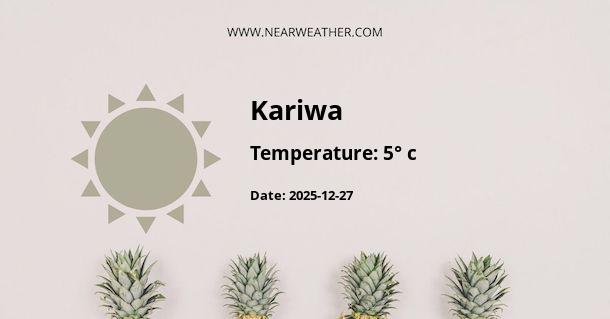Kariwa, Japan: Climate and Weather Year Round
Kariwa is a small town located in the Niigata Prefecture of Japan. Situated on the western coast of Honshu, the largest island of Japan, Kariwa experiences a temperate climate influenced by both the Pacific Ocean and the surrounding mountains. In this article, we will dive into the climate and weather patterns of Kariwa throughout the year.
Temperature
The temperature in Kariwa varies significantly throughout the year. Summers are warm and humid, while winters are cold and snowy. Let's take a closer look at the average temperature ranges for each season:
| Season | Average Temperature Range |
|---|---|
| Spring (March to May) | 8°C (46°F) to 17°C (63°F) |
| Summer (June to August) | 20°C (68°F) to 30°C (86°F) |
| Fall (September to November) | 12°C (54°F) to 22°C (72°F) |
| Winter (December to February) | -2°C (28°F) to 6°C (43°F) |
As the table illustrates, summers in Kariwa are pleasantly warm, with temperatures ranging from 20°C (68°F) to 30°C (86°F). The highest temperatures are typically experienced in August. On the other hand, winters are cold, with temperatures dropping below freezing point. The coldest month is usually January, with temperatures ranging from -2°C (28°F) to 6°C (43°F).
Precipitation
Kariwa receives a moderate amount of rainfall throughout the year, with the highest precipitation occurring during the summer months. Here is an overview of the average monthly precipitation:
| Month | Average Precipitation (mm) |
|---|---|
| January | 41 mm |
| February | 36 mm |
| March | 47 mm |
| April | 66 mm |
| May | 80 mm |
| June | 111 mm |
| July | 166 mm |
| August | 158 mm |
| September | 121 mm |
| October | 88 mm |
| November | 74 mm |
| December | 49 mm |
As seen in the table, the summer months of June, July, and August receive the highest amount of rainfall, with August being the wettest month. This is a result of the monsoon season, which brings heavy showers to the region. However, even during the driest months, Kariwa still receives a considerable amount of precipitation.
Snowfall
Winter in Kariwa is characterized by heavy snowfall, thanks to its proximity to the Sea of Japan and the surrounding mountains. The snow season typically lasts from December to February, with January being the snowiest month. On average, Kariwa receives around 2 meters (6.5 feet) of snow during the winter months. This provides opportunities for winter sports enthusiasts to indulge in activities such as skiing and snowboarding.
Wind Patterns
Kariwa experiences moderate wind patterns throughout the year. The prevailing winds blow from the northwest and are influenced by the surrounding mountain ranges. These winds contribute to the region's cooler temperatures and also play a role in the distribution of rainfall.
Conclusion
In conclusion, Kariwa, Japan, offers a diverse climate throughout the year. With warm and humid summers, cold and snowy winters, and moderate rainfall, Kariwa provides a unique experience for both residents and visitors. Whether it's enjoying the pleasant summer temperatures or embracing the winter wonderland, Kariwa has something to offer for every season.
A - Kariwa's Latitude is 37.429749 & Longitude is 138.618790.
A - Weather in Kariwa is 10° today.
A - Climate Conditions in Kariwa shows overcast clouds today.
A - Humidity in Kariwa is 74% today.
A - Wind speed in Kariwa is 29.88 km/h, flowing at 274° wind direction. today.
